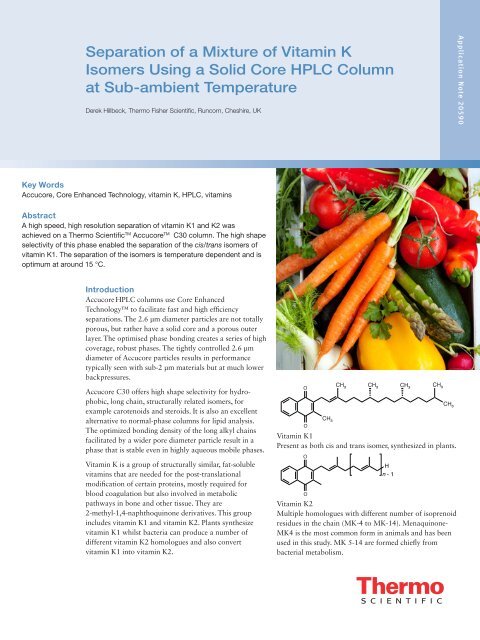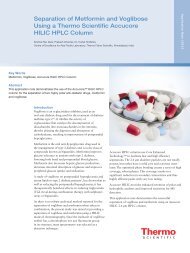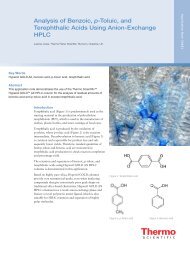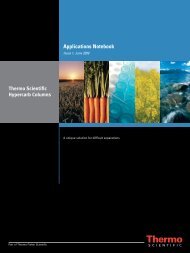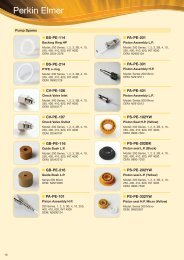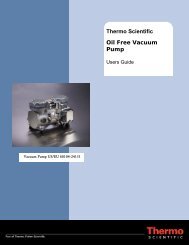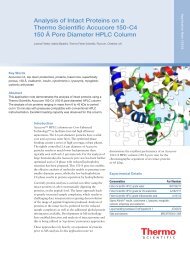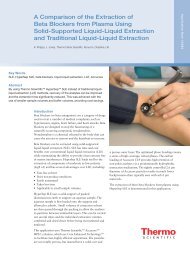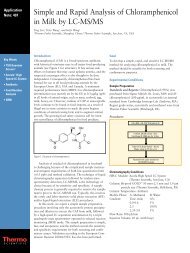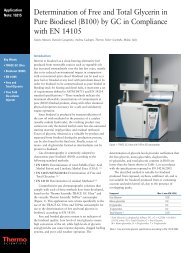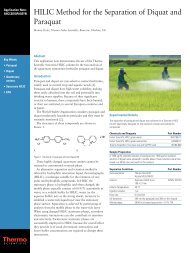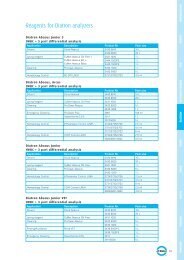Separation of a Mixture of Vitamin K Isomers Using a Solid Core ...
Separation of a Mixture of Vitamin K Isomers Using a Solid Core ...
Separation of a Mixture of Vitamin K Isomers Using a Solid Core ...
You also want an ePaper? Increase the reach of your titles
YUMPU automatically turns print PDFs into web optimized ePapers that Google loves.
<strong>Separation</strong> <strong>of</strong> a <strong>Mixture</strong> <strong>of</strong> <strong>Vitamin</strong> K<br />
<strong>Isomers</strong> <strong>Using</strong> a <strong>Solid</strong> <strong>Core</strong> HPLC Column<br />
at Sub-ambient Temperature<br />
Derek Hillbeck, Thermo Fisher Scientific, Runcorn, Cheshire, UK<br />
Application Note 20590<br />
Key Words<br />
Accucore, <strong>Core</strong> Enhanced Technology, vitamin K, HPLC, vitamins<br />
Abstract<br />
A high speed, high resolution separation <strong>of</strong> vitamin K1 and K2 was<br />
achieved on a Thermo Scientific TM Accucore TM C30 column. The high shape<br />
selectivity <strong>of</strong> this phase enabled the separation <strong>of</strong> the cis/trans isomers <strong>of</strong><br />
vitamin K1. The separation <strong>of</strong> the isomers is temperature dependent and is<br />
optimum at around 15 °C.<br />
Introduction<br />
Accucore HPLC columns use <strong>Core</strong> Enhanced<br />
Technology to facilitate fast and high efficiency<br />
separations. The 2.6 µm diameter particles are not totally<br />
porous, but rather have a solid core and a porous outer<br />
layer. The optimised phase bonding creates a series <strong>of</strong> high<br />
coverage, robust phases. The tightly controlled 2.6 µm<br />
diameter <strong>of</strong> Accucore particles results in performance<br />
typically seen with sub-2 µm materials but at much lower<br />
backpressures.<br />
Accucore C30 <strong>of</strong>fers high shape selectivity for hydrophobic,<br />
long chain, structurally related isomers, for<br />
example carotenoids and steroids. It is also an excellent<br />
alternative to normal-phase columns for lipid analysis.<br />
The optimized bonding density <strong>of</strong> the long alkyl chains<br />
facilitated by a wider pore diameter particle result in a<br />
phase that is stable even in highly aqueous mobile phases.<br />
<strong>Vitamin</strong> K is a group <strong>of</strong> structurally similar, fat-soluble<br />
vitamins that are needed for the post-translational<br />
modification <strong>of</strong> certain proteins, mostly required for<br />
blood coagulation but also involved in metabolic<br />
pathways in bone and other tissue. They are<br />
2-methyl-1,4-naphthoquinone derivatives. This group<br />
includes vitamin K1 and vitamin K2. Plants synthesize<br />
vitamin K1 whilst bacteria can produce a number <strong>of</strong><br />
different vitamin K2 homologues and also convert<br />
vitamin K1 into vitamin K2.<br />
O<br />
O<br />
<strong>Vitamin</strong> K1<br />
Present as both cis and trans isomer, synthesized in plants.<br />
O<br />
O<br />
H<br />
n - 1<br />
<strong>Vitamin</strong> K2<br />
Multiple homologues with different number <strong>of</strong> isoprenoid<br />
residues in the chain (MK-4 to MK-14). Menaquinone-<br />
MK4 is the most common form in animals and has been<br />
used in this study. MK 5-14 are formed chiefly from<br />
bacterial metabolism.
2 Experimental Details<br />
Consumables<br />
Part Number<br />
Fisher Scientific HPLC grade water<br />
W/0106/17<br />
Fisher Scientific HPLC grade methanol<br />
M/4056/17<br />
Fisher Scientific HPLC grade acetonitrile<br />
A/0626/17<br />
Thermo Scientific Premium 8 mm thread, 2 mL clear screw vial, seal, cap (convenience pack) 60180-600<br />
<strong>Vitamin</strong> K1 and vitamin K2 standards were obtained from a commercial supplier<br />
<strong>Separation</strong> Preparation<br />
Working standards were prepared to 200 µg/mL in acetonitrile<br />
<strong>Separation</strong> Conditions<br />
Instrumentation:<br />
Thermo Scientific Accela UHPLC system<br />
Part Number<br />
Column: Accucore C30 2.6 µm, 100 x 2.1 mm 27826-102130<br />
Mobile phase:<br />
Column temperature: 15 °C<br />
Injection details:<br />
Injection wash solvent:<br />
UV detector wavelength:<br />
Backpressure:<br />
4% water: 96% methanol isocratic method<br />
2 µL partial loop<br />
20:80 (v/v) water / acetonitrile<br />
250 nm<br />
220 Bar at 350 µL/min<br />
Results<br />
<strong>Vitamin</strong> K2 elutes first followed at twice the retention, by the cis and trans isomers <strong>of</strong> vitamin K1.<br />
The larger <strong>of</strong> this pair corresponds to the trans isomer.<br />
The resolution between this critical pair can be controlled by adjusting the column temperature.<br />
At temperatures above 20 °C the two isomers become unresolved.<br />
1400<br />
1200<br />
1000<br />
35 ºC<br />
800<br />
mA U<br />
30 ºC<br />
600<br />
25 ºC<br />
400<br />
20 ºC<br />
200<br />
15 ºC<br />
0<br />
6.0 6.5 7.0 7.5 8.0 8.5 9.0<br />
Minutes<br />
Figure 1: Chromatograms showing the effect <strong>of</strong> column temperature on the retention time and resolution <strong>of</strong> the<br />
critical pair <strong>of</strong> vitamin K1 isomers. Lower trace 15 °C, incrementing upwards at 5 °C.
The Accucore HPLC column provides good efficiency over a wider range <strong>of</strong> flow rates than with<br />
fully porous material. This was demonstrated by running the method at six different flow rates and<br />
examining the effect on the retention and resolution <strong>of</strong> the peaks from the vitamin K1 pair <strong>of</strong><br />
isomers<br />
3<br />
1600<br />
1400<br />
1200<br />
500 µL/min<br />
1000<br />
450 µL/min<br />
mAU<br />
800<br />
400 µL/min<br />
600<br />
1<br />
350 µL/min<br />
400<br />
200<br />
2<br />
300 µL/min<br />
0<br />
250 µL/min<br />
0 1 2 3 4 5 6 7 8 9 10<br />
Minutes<br />
Figure 2: Chromatograms showing the effect <strong>of</strong> flow rate on the retention time and resolution <strong>of</strong> the vitamin K1<br />
and K2 mixed standard. Lower trace 250 µL/min, incrementing upwards at 50 µL/min intervals.<br />
1. vitamin K2 2. vitamin K1 (trans isomer) 3. vitamin K1 (cis isomer)<br />
3<br />
Flow rate (µL/min)<br />
Resolution K1 isomers<br />
Column backpressure<br />
(bar)<br />
250 2.012 163<br />
300 1.895 193<br />
350 1.782 221<br />
400 1.690 248<br />
450 1.588 273<br />
500 1.488 295<br />
Table 1: resolution and backpressure achieved at different flow rates<br />
Baseline resolution is achieved even at the elevated flow rates, and with backpressures compatible<br />
with conventional HPLC equipment. The analysis can be completed in under 4 minutes when using<br />
the 500 µL/min method.<br />
A flow rate <strong>of</strong> 350 µL/min with column temperature <strong>of</strong> 15 °C was selected and replicate injections<br />
made to demonstrate the reproducibility <strong>of</strong> the method.
600 1<br />
mAU<br />
500<br />
400<br />
300<br />
2<br />
Application Note 20590<br />
200<br />
100<br />
3<br />
0<br />
0 1 2 3 4 5 6 7 8<br />
Minutes<br />
Figure 3: Chromatogram showing the separation <strong>of</strong> vitamin K compounds using the final method conditions<br />
1. vitamin K2 2. vitamin K1 (trans isomer) 3. vitamin K1 (cis isomer)<br />
<strong>Vitamin</strong> K2 retention<br />
time (min)<br />
<strong>Vitamin</strong> K1 (trans)<br />
retention time (min)<br />
<strong>Vitamin</strong> K1 (cis)<br />
retention time (min)<br />
Resolution between<br />
<strong>Vitamin</strong> K1 isomers<br />
Mean 2.93 5.63 6.02 1.79<br />
CV 0.1% 0.1% 0.1% 0.2%<br />
Table 2: Results <strong>of</strong> replicate analysis (n=6) showing retention time and resolution achieved<br />
Conclusion<br />
The use <strong>of</strong> an Accucore C30 column enables the analysis <strong>of</strong> vitamin K compounds in less than<br />
6 minutes and at standard HPLC backpressures. Sub-ambient temperature control improves<br />
resolution <strong>of</strong> isomeric forms <strong>of</strong> vitamin K1. Faster methods are possible by increasing the flow rate<br />
whilst maintaining acceptable critical pair resolution.<br />
thermoscientific.com/chromatography<br />
© 2012 Thermo Fisher Scientific Inc. All rights reserved. All trademarks are the property <strong>of</strong> Thermo Fisher Scientific Inc. and its subsidiaries. This information is<br />
presented as an example <strong>of</strong> the capabilities <strong>of</strong> Thermo Fisher Scientific Inc. products. It is not intended to encourage use <strong>of</strong> these products in any manners that<br />
might infringe the intellectual property rights <strong>of</strong> others. Specifications, terms and pricing are subject to change. Not all products are available in all countries.<br />
Please consult your local sales representative for details.<br />
USA and Canada +1 800 332 3331<br />
France +33 (0)1 60 92 48 34<br />
Germany +49 (0) 2423 9431 20 or 21<br />
United Kingdom +44 (0)1928 534110<br />
Japan +81 3 5826 1615<br />
AN20590_E 09/12S<br />
China +86 21 68654588 +86 10 84193588<br />
+86 20 83145199 800 810 5118<br />
India +91 22 6742 9494 +91 27 1766 2352<br />
Australia 1 300 735 292 (free call domestic)<br />
New Zealand 0800 933 966 (free call domestic)<br />
All Other Enquiries +44 (0) 1928 534 050<br />
Technical Support<br />
North America +1 800 332 3331<br />
Outside North America +44 (0) 1928 534 440


